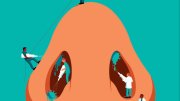Harvard College has only one course required of every student: “Expository Writing.” Better known simply as “Expos,” the class urges freshmen to “concentrate directly on the craft of composing and revising their ideas.” Among the skills to be learned in Expos is one that Kaavya Viswanathan ’08 might have found useful when writing her novel, How Opal Mehta Got Kissed, Got Wild, and Got a Lifeavoiding plagiarism.
Plagiarism, the slim Expos booklet Writing with Sources explains, “is an act of lying, cheating, and stealing.” Harsh words, but senior preceptor Gordon Harvey, the man who wrote them, who is also assistant director of the Expos program, has a somewhat more understanding attitude. “It’s about pressure,” he says: pressure to produce, achieve, and compete. Tight deadlines combined with copying and pasting notes from on-line sources “can create genuine accidents. You run out of time and it’s hard to go back [for proper citations].”
|
He distinguishes, though, between a genuine mistake and “fraudpassing off something as yours, the work for which was done by somebody else.” Harvey reports that, during his three years on the College’s disciplinary body, the Administrative Board, student after student claimed photographic memory, but cases typically involved “passages of such complexity that it was rarely plausible.” The questionable passages in Opal Mehta reflect Megan McCafferty’s novel Sloppy Firsts so closely that they “could only have happened with extensive notes, or if [Viswanathan] had the book open in front of her,” Harvey declares. “What we would look for on the Ad Board is evidence that things had been changed to hide [copying].”
Harvey, however, is less concerned with catching every misattributed quotation than with the chilling effects that strict enforcement can have. Each year, he notes, terrified freshmen turn in “massively footnoted” essays the week after lectures on plagiarism. “It can be paralyzing” to have so many rules, he says. “You don’t want to kill the fun of reading something and liking it, and wanting to use the idea.”
His solution lies in having instructors build better assignments that give students a unique space to write, in which experts have not yet exhausted all the possibilities and other students have not written essays available wholesale on the Internet. Such direct cheating, Harvey warns, is rarely worth it, because “if it’s on-line for them, it’s on-line for us. It’s somewhat befuddling that [such cheating] goes on as much as it does.” Some universities, Princeton among them, use automated services to check essays for originality. Harvard has not implemented such a system University-wide, although the government department’s sophomore tutorial and several other large classes require electronic submission as an anti-cheating measure. “There’s something tacky and against the spirit of the University about that,” Harvey believes. “I would vote for the honor code, and getting faculty to think about assignments” that will get students engaged in “wrestling with the material.”
~John La Rue





